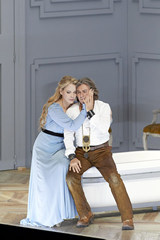| Opera Reviews | 19 April 2024 |
Musically excellent but an unfulfilled productionby Moore Parker |
|
| Saint-Saëns: Samson et Dalila Vienna State Opera 28 May 2018 |
|
|
Ms. Liedtke’s setting points toward modern-day Semitic strife - albeit, placed in visuals quite unspecific and featuring costumes by Su Bühler which could in part have easily served the 60’s Broadway production of the musical Fiddler on the Roof. The main three protagonists have evidently enjoyed the most detailed direction, leaving supports and choral scenes generally stilted and often painfully dull in their stage work. Raimund Orfeo Voigt’s sets feature an enormous rotatable catwalk for Act 1, a cube-like living space for Act 2 which opens out in panels (effective, the slit-like opening specifically underscoring the context in Dalila’s "Samson, recherchant ma présence..") as required, ultimately to reveal a generous-sized bathroom with a water-filled tub from which Samson and Dalila petulantly splash each other during their lengthy confrontation. However, powerful staging for Delilah’s "Mon coeur s’ouvre à ta voix" in which she strategically remains upstage facing the auditorium while Samson is left to wrangle in the shadow of her potency. Near the end the act, the heavens open and the stage is drenched by a downpour. How Samson’s sight is lost remains a mystery, and Dalila takes no more than a paltry lock or two of Alagna’s flowing bob as a token gesture to the plot. Act 3 introduces a front-to-rear platform for Samson’s "Vois ma misère, hélas!" - subsequently to be flanked left and right by Philistine party-goers in evening wear taunting the blinded victim, and an orgiastically-sadistic bacchanale (choreography, Lukas Gaudernak) in which a Samson is given a counterpart who is ridiculed and physically abused. An enormous bank of spots illuminates the central action - leading one to think that maybe a Harold Prince “White Out” (used initially in the musical Evita) might be the show-closer option. However, the surprise comes when Samson’s double ignites inflammable strips on his arms and back, and signals the combustion of flares which soar upward from around the stage to bring down the final curtain. Some quirky sparks of inspiration included unfamiliar sexual tension between Dalila and the High Priest, and the portrayal of the Old Hebrew as being a blind keeper of the faith (in some way drawing reference to Samson’s fate). If the crowd scenes were the most underdeveloped dramatically, at least some of the more intimate moments - in particular, Dalila and the High Priest’s Act 2 "J’ai gravi la montagne," and the same Act’s fiery "Mais !…Non ! Que dis- je , hélas!" between Samson and Dalila took flight. Both duos were pregnant with tension and subtle interaction - and were indeed the highlights of the evening’s staging. If the overall concept has potential, it remains sadly unfulfilled as a Gesamtkunstwerk, despite what must have been an arduous and expensive endeavour. The romantic leads both suffered essential incongruities, with Roberto Alagna rather bound by his inimitable boy-next-door physique and image - and to a lesser degree, Garanča’s pristine Grace Kelly glamour. However, the Italo-French tenor certainly rose to the challenge with his highly-focussed, penetrating tone generally compensating for an instrument of more natural depth and with this updated, cosier version playing in his favour (in comparison to more traditional heroic portraits familiar with tenors such as Vickers, Domingo, Cossutta, to mention but three). Alagna paced himself well, generally meeting the score’s dramatic demands (sometimes with stentorian passages above the stave) and only very occasionally showing moments of slight fatigue in which pitch and tonal purity became a touch jaded. An unquestionable achievement. Elīna Garanča’s stunning presence is in itself beguiling, and her cool demeanour well suits the heroine’s calcul in certain respects, with this modern setting certainly to her advantage. While lacking the brilliant upper harmonics and metal which contributed to another non-heavyweight mezzo, Agnes Baltsa’s success in the part (in addition to lacking the ideal vocal substance and bite in her mid and lower registers) Garanča made much of her opportunities, building in sonority and impact throughout to culminate in her final aria and subsequent duet with Alagna. As the High Priest Carlos Álvarez gave an unquestionably competent reading, vocally solid, and portrayed here as a cigar-puffing mobster who in the finale gladly accepts Dalila’s return of the knife he has thrust in her hand to do the dirty job of finishing Samson off. The supporting roles hinted at caricature at times with Act 1’s plot unfolding in the most unconvincing manner. Dan Paul Dumitrescu’s Old Hebrew failed to quite ring true dramatically or vocally, while Sorin Coliban’s short-lived Abimélech left a booming - if vocally somewhat boorish - impression. The Vienna Opera Orchestra under Marco Armiliato was well studied, but at times appeared restrained in tempi and sheer verve ("Mon coeur s’ouvre à ta voix" dragged irritatingly for example) and lacking in impulse. However, overall coordination was excellent between stage and pit, and the work’s vital choral scenes were savoured grandly by all parties.
|
|
| Text ©
Moore Parker Photo © Wiener Staatsoper / Michael Pöhn |

 Almost a quarter of a century has passed since Saint-Saëns’ Samson et Dalila was last featured in the Vienna State Opera’s repertoire, with this latest interpretation seeing the house debut of director Alexandra Liedtke, as well as role debuts for both Roberto Alagna and Elīna Garanča in the tenor and mezzo leads.
Almost a quarter of a century has passed since Saint-Saëns’ Samson et Dalila was last featured in the Vienna State Opera’s repertoire, with this latest interpretation seeing the house debut of director Alexandra Liedtke, as well as role debuts for both Roberto Alagna and Elīna Garanča in the tenor and mezzo leads. 





